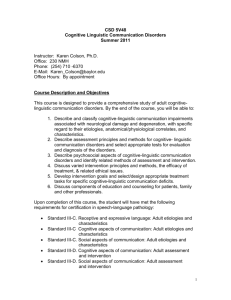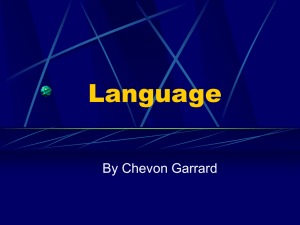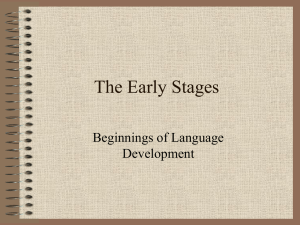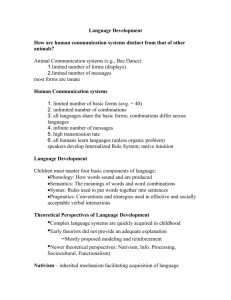Language Disorders
advertisement
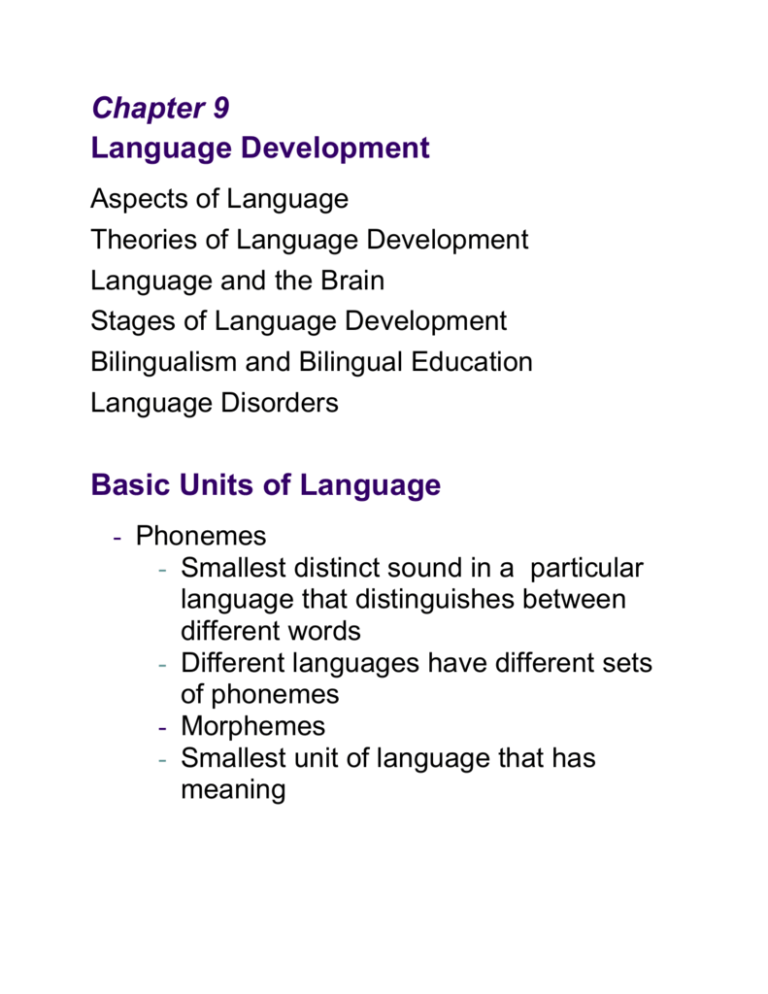
Chapter 9 Language Development Aspects of Language Theories of Language Development Language and the Brain Stages of Language Development Bilingualism and Bilingual Education Language Disorders Basic Units of Language - Phonemes - Smallest distinct sound in a particular language that distinguishes between different words - Different languages have different sets of phonemes - Morphemes - Smallest unit of language that has meaning What’s in a Language? Phonology: the sounds of a language Syntax: the grammar of a language Semantics: the meaning of words Pragmatics: how language is used Theories of Language Development Behaviorism & Social Cognitive Learning Theory Nativism Interactionism Cognitive Processing Theory Behaviorism and Social Cognitive Learning Theory Social cognitive learning theory: learning language by imitation Behaviorism: language is shaped by operant conditioning (B.F. Skinner) Research says: mothers who vocalize more have children who vocalize earlier and more (Tamis-LeMonda, Bornstein, & Baumwell, 2001) Nativism Universal grammar (Chomsky) hardwired grammatical structure present in the brain that is activated by hearing language in the environment Research says: children use sentences they have never heard overregularization supports that there are inborn rules that children follow when learning language Interactionism Behaviorism + Nativism = Interactionism Biological readiness to learn language interacts with language in the environment to allow language learning Language is created socially through interaction between adult and child Cognitive Processing Theory Language learning is a process of “data crunching”: children take in and process the language they hear Learning relies on computational ability of the human brain Research says: - infants process language well before they can speak Research on cognitive processing theory Infants can differentiate “words” from a series of syllables in a row by using the frequency with which some syllables end up beside other syllables and the frequency with which others do not This phenomenon is called statistical learning Language and the Brain Language-specific areas of the brain Expressive vs. Receptive language Broca’s Area Involved in speech production Located near the motor center that produces movement of the lips and tongue Damage: trouble speaking (leave out noncrucial words) tend to use telegraphic speech (like toddlers) Wernicke’s Area Involved understanding and creating meaning in speech Located near the auditory center of the brain Damage: trouble making sense; but no trouble producing actual words Expressive vs. Receptive Language Difference between comprehension and production Throughout the lifespan, people generally understand more words than they produce. Almost universally, comprehension is always greater than production. Stages of Language Development Prenatal development Preverbal communication Toddlers Preschoolers School-aged children Adolescents Prenatal Development A fetus can hear many things in utero Research says: infants prefer the sound of their mother reading a The Cat in the Hat when they heard her read it prenatally to the sound of her reading something else Newborns also show a preference for the language that their mother speaks. Preverbal Communication Crying Cooing Babbling Crying Begins as a reflexive behavior, but becomes intentional Parents and caregivers can differentiate the severity and intensity of the cry, but not the specific reason for the cry. Cooing Starts between 2 and 4 months Sounds like doves cooing (no clear syllables) Beginnings of conversational rules Starting to learn how to use language http://www.youtube.com/watch?v=MZJzF0Z mFgY Babbling Early babbling: repetition of the same sound http://www.youtube.com/watch?v=7RqUTJA fy48 Expressive babbling: repetition of a variety of mixed sounds http://www.youtube.com/watch?v=MfkHtamYLU&NR=1 Early words for mom and dad originate from these earliest sounds (i.e., ma, da, ba) How Adults Foster Language Development Child-directed speech Shared Attention, Gestures, Sign Language Child-directed Speech Also called infant-directed speech or “motherese” High pitched voice, exaggerated pitch, slower speech Hypothesized to increase the child’s attention to speech Very similar aspects of infant-directed speech across the languages of the world Shared attention, Gestures, Sign Language Adults tend to label things that children are attending to (they share the attention) Infants use gestures before they speak, and continue to use them along with speech Infant sign language is hypothesized to build on infants early gesture use to try to reduce frustration and allow more communicative opportunities http://www.youtube.com/watch?v=7gSZfW4 gVhI Toddlers: Words and Sentences Vocabulary burst: A period of time in which the learning of new words happens rapidly. Some children learn words more gradually. Parents often can’t keep up with writing down the child’s productive vocabulary because they use new words so frequently Telegraphic speech Sounds like a telegram because the inconsequential words are left out “want bear” vs. “I want the bear” http://www.youtube.com/watch?v=zzWt MNZzCjo&feature=PlayList&p=66264D1 ACFCB17E3&playnext_from=PL&playn ext=1&index=23 Biases and Constraints Children use constraints to form hypotheses about the names for things in the environment. Whole Object Bias Bias that a word (“mug”) is naming the whole object, rather than a part of that object (like the handle) Mutual Exclusivity Children assume there is one and only one name for an object. Thus, if an object has a name, a new label must refer to an object that is as yet unnamed. Taxonomic constraints Two objects with features in common can have a common name, but each object also needs an individual name For example, “cow” and “dog” are both “animals,” but since cow and dog are different they retain their individual labels as well. Fast mapping Fast mapping is learning words from what seems to be a single exposure to the new label. Syntactic bootstrapping Children use the knowledge they have in one domain of language (like word meaning) to learn in another domain (like word order). Preschoolers The role of environment: Children from families with professional parents hear significantly more words than children in working class families or families on welfare (Hart & Risley, 1995). The number of complex sentences that children use also varies by educational level of parents. Differences in Toddler’s Vocabulary Egocentric vs. Private Speech Egocentric speech: children's inability to take the role of other people in conversations Private Speech: speech to oneself (begins aloud and increasingly becomes silent) How language develops according to Piaget and Vygotsky Piaget presocial speech egocentric speech socialized speech Vygotsky social speech communicative speech private speech inner speech/thought Written Language Ability to understand and use written language Though usually the context for written language is school, emergent literacy happens earlier Phonological awareness emerges around 3 or 4 Dialogic Reading Reading between an adult and a child – essential that both play the roles of the storyteller and the active listener/questioner PEER Prompt Evaluate Expand Repeat Types of Prompts Completion Recall Open-ended W-prompts Distancing prompts School-Aged Children Metalinguistic Skills Humor Reading Writing Metalinguistic Skills Children begin to think about language and how to use it Also come to understand that words are not the same as what they stand for (i.e., the word “cup” has no actual resemblance to a cup) Humor Methods for Teaching Reading Phonics Letter-sound relationships Whole language Using reading materials with inherent interest for the child Balanced reading approach Combines elements of phonics and whole language Writing Skills Begins with inventive spelling, but early elementary children learn to apply conventional rules Communicating ideas Knowledge telling Knowledge transforming Teenagers Increasingly using electronic communication like text messaging and instant messaging Teenagers also develop their own vocabulary to use with peers (i.e., slang) Childhood Bilingualism Children learning two languages simultaneously reach milestones at about the same time as those learning one No strong evidence that early bilingualism gives global cognitive advantage Learning a second language prior to adolescence improves aspects of that language Bilingual classrooms Transitional bilingual education programs Developmental bilingual programs Dual language programs http://www.youtube.com/watch?v=T9jWkO1 g_oc&feature=related Language Disorders Communication disorders Autism Spectrum Disorders Learning Disabilities Communication Disorders Expressive language disorder Phonological disorder Receptive-expressive language disorder Stuttering Autism Spectrum Disorders Spectrum from PDD to Autism Communication Issues Smaller than average vocabulary Echolalia Non-verbal communication is impaired Learning disabilities Impairments in the ability to understand and/or use spoken or written language Dyslexia: difficulty distinguishing or separating the sounds of spoken words Creates problems with learning to spell and reading written words Dysgraphia: trouble with spelling, handwriting, and expressing thoughts through written words Learning Disabilities Disabilities that include impairments in the ability to understand or use spoken and/or written language Dyslexia: difficulty distinguishing or separating the sounds of spoken words Creates problems with learning to spell and reading written words Dysgraphia: trouble with spelling, handwriting, and expressing thoughts through written words Conclusion Language is essential to the human experience. Children go through stages in learning language Children must also learn to decipher written language if they live in a literate society. Communication disorders must be treated. Language is a central aspect of children’s cognitive development

